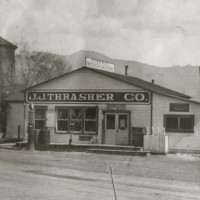History


The former J.J. Thrasher Co. building is now home to the Burning Man office.
Overview: The town of Gerlach was settled in 1906 when the Western Pacific Railroad was built. Named for Gerlach Land and Livestock Company from the Gerlach and Waltz Ranch, owned by Louis Gerlach. The Gerlach Post Office opened its doors on October 9, 1909.
At it’s peak in the 1950’s the population totaled over 1,000 residents. Gerlach was home to two restaurants, five bars, two motels and a handful of other small businesses. In 2011, the nearby U.S. Gypsum mine in Empire, Nevada closed, and the population declined to roughly 100 year-round residents where it stands today.
Situated between Black Rock Desert on the east and Smoke Creek Desert on the west, the townsite of Gerlach lies in country long occupied by prehistoric man. John C. Frémont traveled through Northern Paiute Indian lands when he camped here in 1843 and named “Boiling Springs” 1/4 mile north of town. This was also emigrant country; the Noble Road left the Applegate-Lassen Trail at Black Rock Springs, went past this site and southward through Smoke Creek Desert toward Susanville. The town was established when the Western Pacific Railroad was constructed in Nevada 1905-1909.
Trains are an integral part of Gerlach’s history. The Feather River Route of the Western Pacific was established through the Black Rock Desert in 1906. This route ran over 800 miles starting in Salt Lake City, Utah pushing onward over the Sierras to Oakland, California. The incentive for this new route can be attributed to Beckwourth Pass, 20 miles east of Portola. The selection of the pass established a rail line through lowest pass in the Sierra at 5, 221′ which is 2,000 feet lower than the Transcontinental Railroad Summit Tunnel established in 1869 on Donner Pass.
The flat terrain in the Great Basin and particularly the Black Rock Desert provided ideal geography for laying down the rail lines. However the searing heat which could exceed 115 degrees Fahrenheit and the scarcity of water made construction just as treacherous and labor intensive as the rugged Sierra Nevada. Heat stroke and exhaustion were common as were breathing ailments from the alkaline dust storms. Work turnover increased with the searing temperatures which resulted in construction delays that threatened the rails completion.
The abundance of water, evident by hot springs in the area, resulted in the WP establishing a station at Trego Hot Springs as well as a train yard in Gerlach. The water was crucial for filling the steam engine boilers. Freight engineers were also known to enjoy soaking in the hot springs during breaks at Trego.
Once Gerlach was officially established as a rail yard and train stop, the Western Pacific railroad built employee housing along with the station house, telegraph, and post office. Two water towers were eventually constructed of redwood along Main Street. One tower provided drinking water while the other was reserved for the trains. Once the trained stopped, the boiler man would climb on top of the train, pull down the water spigot using a chain, and fill tender and boiler. Each water tower had the capacity to hold over 40,000 gallons of water. Steam engines typically stopped every 90-100 miles to refill.
The railroad made life in Gerlach possible, and a new community bloomed in the desert with the amenities provided by the Western Pacific. The first steam engine to travel through Gerlach after the completion of the Feather River route in 1909 was the Western Pacific 94, a 4-6-0 ten wheeler which is now on display at the California Rail Museum in Suisun, California. Quickly after the completion of the route, it was noted as being one of the most scenic railways in the country.
Content contributed by Christina Preston
Please help us build historical archives for Gerlach. If you have historical images and history to share, please contact our webmaster so that we can build out this section of our website. Thank you.
